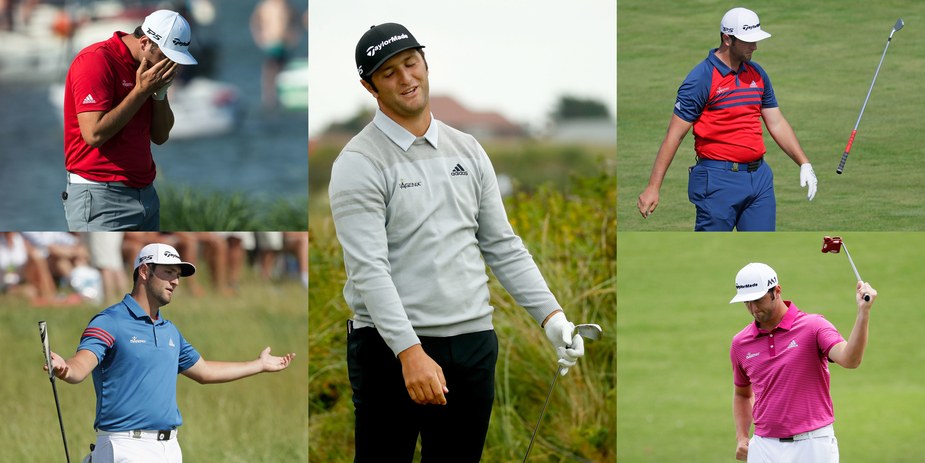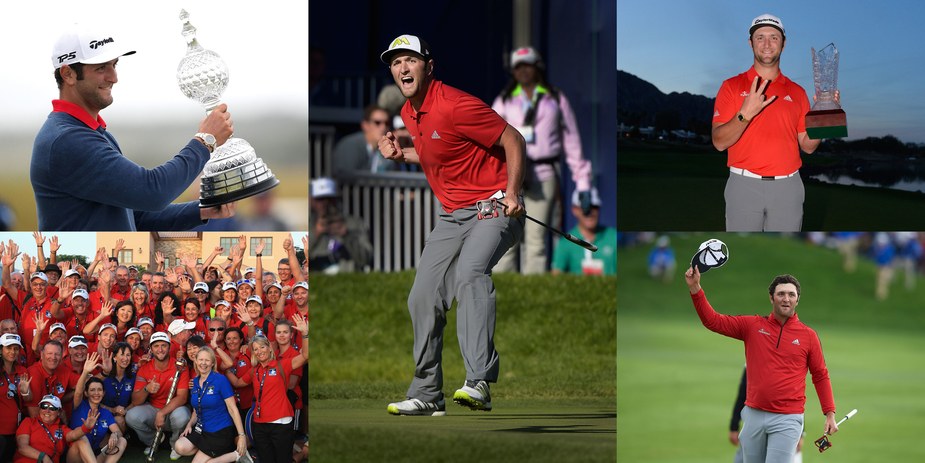Jon Rahm is a conundrum. Figuring him out is extremely difficult because he appears at times to be two people.
His golf is precocious – almost frighteningly so. On Sunday, he won the Spanish Open, delighting the Spanish crowd by shooting a final-round 67 to overtake Paul Dunne and win for the first time in his native country by two strokes.
It was Rahm’s third win on the European Tour, to go with two on the US PGA Tour. He turned pro in June 2016, right after finishing T-23 to be the low amateur in the US Open at Oakmont. Do the math: He’s now won five times in 22 months as a pro. For anyone wondering how he could be ranked fourth in the world already, that’s how you do it.
Perhaps just as important as the victory on home ground in Spain, Rahm finished fourth, eight days ago at the Masters, the first time he’s played well in a Major since turning pro. His performance as an amateur at Oakmont had produced his best finish in six starts in Majors prior to a week ago Sunday at Augusta.
Rahm has it all: prodigious talent, the ability to close when he’s in contention, charm and good looks, and more money than he can possibly know what to with right now.
But …
The temper.
It isn’t just that Rahm has flashes of frustration or drops an occasional profanity. He tends to go well beyond that. At the US Open at Erin Hills last June, he had an epic meltdown on the 14th hole on Friday after butchering a chip that would lead to a bogey. There had already been glimpses of frustration, but it all peaked at that moment: a loud F-bomb, followed by a slammed wedge, a kicked wedge (tough day for that wedge) and, when he got to the 15th tee, a hurled golf ball, followed by a punch to the tee sign. He then birdied the 15th, but still ended up five-over for 36 holes – four strokes outside the cut.
At Phoenix in February, where Rahm entered the final round one shot out of the lead, another poor wedge shot, this one on 15, led to another slammed club and more anger and, ultimately, a one-over 72 that dropped him to T-11 for the tournament.

Rahm doesn’t defend his tantrums but has said in the past that losing his temper allows him to vent and free himself up when frustrated. After the US Open debacle, he likened himself to a bottle of soda that’s been shaken up and needs to explode. (It’s also worth noting that Tiger Woods, arguably the greatest player of all time, is still – according to US PGA Tour sources – one of the most fined players of all time for bad on-course behaviour.)
Greatness often comes with an edge and, at just 23, Rahm clearly has greatness in him. What’s more, he may not be under the microscope Woods has played his career under – no one ever has been – but he is being watched at all times. That’s what comes with early success and a career path that has gone straight up since he first arrived at Arizona State six years ago.
Rahm spoke almost no English when he landed in Tempe, but speaks the language fluently now with only the slightest hint of an accent. He won the Ben Hogan Award twice while playing for the Sun Devils and his 11 tournament titles fell short of only one other Arizona State player – Phil Mickelson, who won 16.
Rahm was so good in college that his coach – Mickelson’s brother Tim – did the same thing that Phil’s college coach – Steve Loy – did, giving up coaching to become his agent. Now, Tim is caddieing for his brother, which may or may not be more lucrative than representing Rahm.
By the time he got to Erin Hills last June, he was ranked 10th in the world. He played so well in his first starts as a pro that he didn’t need Q school or the Web.com Tour to earn a US PGA Tour card. He had won in San Diego – punctuating the victory by making a 65-foot eagle putt on the 18th green at Torrey Pines – plus had two second-place finishes (one to Dustin Johnson in the WGC-Match Play) a third, a fourth and a fifth. If it was Sunday on the US PGA Tour, Rahm was on a leaderboard somewhere. Or so it seemed.

Less than a month after the Erin Hills meltdown, Rahm won in Ireland although the victory wasn’t without controversy because of a question that arose as to whether he mis-marked his ball on the sixth green. The European Tour ruled he had not done so, but there was almost as much talk about that as about his six-shot victory.
It doesn’t take much to become a controversial figure in golf. People still cluck to this day about Patrick Reed declaring himself one of the five best players in the world four years ago after winning three times in eight months – though not so much after his victory at Augusta.
Any sign of losing his temper is going to put Rahm under the microscope again. The internet was full of comments after Erin Hills from angry parents about what a poor example he is for children. That’s life when you are (now) the No.4 ranked player in the world and considered by some either the best player in the world (or perhaps second best behind Rickie Fowler) without a Major title.
Of course, Rahm has only had seven cracks at the weekends that matter most (Fowler’s had 33), and his performance at the Masters was certainly a good sign for those who think he is about to graduate from rising star to superstar.
It was also a good sign for European Ryder Cup captain Thomas Bjorn, for whom Rahm will be playing in Paris this coming September. Rahm will probably be one of three Spanish players in Bjorn’s lineup along with Sergio Garcia and Rafael Cabrera-Bello.
The latter two were a solid team at Hazeltine National, and Bjorn may not want to break them up. On the other hand, he may want the calming influence of Garcia, who has played in eight Ryder Cups, alongside the hot-tempered Rahm. Garcia’s been there, done that when it comes to venting on the golf course. He might be the perfect partner for the new Spanish star.
Make no mistake, Rahm is going to play in a lot of Ryder Cups and contend in many Majors. The question, at least for the moment will be whether he explodes into stardom in those moments or simply explodes.
We will all, no doubt, be watching.

